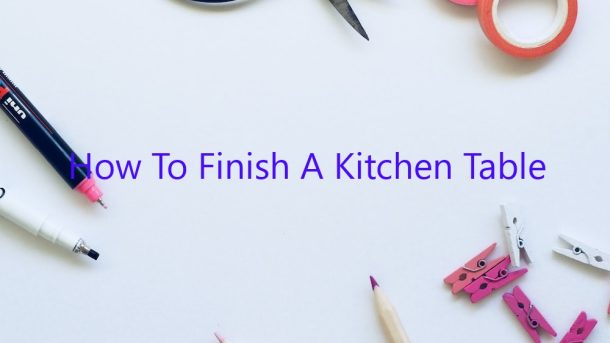Kitchen tables provide a space for dining and can also be used as a work surface. They come in a variety of shapes, sizes and materials. You can finish a kitchen table in a variety of ways, depending on your needs and preferences.
One popular way to finish a kitchen table is to apply a coat of sealant. This will protect the table from water and other liquids. You can also use a sealant to give the table a glossy or matte finish.
Another option is to apply a coat of paint. This can be done in a variety of colors, and it will protect the table from scratches and other damage.
If you want to give your kitchen table a rustic look, you can apply a coat of wax. This will give the table a natural finish and will also protect it from liquids and scratches.
Finally, you can also use a varnish to finish your kitchen table. This will give the table a glossy finish and will protect it from water and other liquids.
Which finish you choose will depend on your needs and preferences. Be sure to read the instructions carefully and to follow the directions provided.
Contents
What is the best finish to put on a table top?
A table top can be finished with a variety of different coatings, each with their own benefits and drawbacks. The three most common finishes for table tops are polyurethane, lacquer, and varnish.
Polyurethane is a clear, plastic-like coating that is applied in several coats. It is the most durable finish, and is scratch and water resistant. However, it is also the most difficult to apply, and can be difficult to repair if it is scratched or damaged.
Lacquer is a clear, glossy finish that is applied in a single coat. It is durable and water resistant, and is easy to repair if it is scratched or damaged. However, it is not as scratch resistant as polyurethane, and can yellow over time.
Varnish is a clear, matte finish that is applied in a single coat. It is durable and water resistant, and is easy to repair if it is scratched or damaged. However, it is not as durable as polyurethane or lacquer, and can chip and peel over time.
What kind of polyurethane do you use on a kitchen table?
There are many types of polyurethanes available on the market, so it can be confusing to know which one to choose for a project. In general, there are two types of polyurethanes: oil-based and water-based.
Oil-based polyurethanes are typically more durable and resistant to staining than water-based polyurethanes. However, they are also more toxic and can give off harmful fumes, so they should not be used in a confined space, such as a kitchen.
Water-based polyurethanes are less toxic and less smelly than oil-based polyurethanes, making them a better choice for a kitchen table. However, they are not as durable as oil-based polyurethanes and may not be as resistant to staining.
How do you finish a homemade table?
Finishing a homemade table can be a challenge, but with the right steps, it can be done. The first step is to make sure the table is completely sanded and smooth. Then, apply a coat of primer to help the paint stick better. After the primer dries, paint the table with a coat of your chosen color. Once the paint dries, add a sealant to protect the paint from scratches and spills. Finally, add any desired decorations to the table.
What is the best finish for a dining room table?
When it comes to finishing a dining room table, there are a few different options to choose from. In this article, we will discuss the pros and cons of each type of finish, so that you can make the best decision for your needs.
One option is to use a sealer. Sealers are applied to wood in order to protect it from water, stains, and scratches. They come in both matte and glossy finishes, and can be either transparent or opaque. Sealers are a good option for those who want to protect their table from everyday wear and tear, but they will not give the table a glossy finish.
Another option is to use a finish coat. Finish coats come in both a satin and a glossy finish, and they are applied over a sealer. They provide a little more protection than a sealer, and they also give the table a glossy finish. However, they are not as durable as a sealer, so they may need to be reapplied more often.
The final option is to use a sealer and a finish coat together. This is the most durable option, and it will give the table both a satin and a glossy finish. It is also the most expensive option, so it may not be the best choice for everyone.
When choosing a finish for your dining room table, it is important to consider your needs and preferences. If you are looking for a durable finish that will protect your table from scratches and stains, then a sealer and a finish coat is the best option. If you are looking for a glossy finish, then a finish coat is the best option. However, if you are looking for a less durable finish that will need to be reapplied more often, then a sealer or a sealer and finish coat combination is the best option.
What do you seal a kitchen table with?
There are a few different things you can use to seal a kitchen table. One option is to use a sealant, such as polyurethane. You can also use a wax, such as beeswax, or a sealant wax, such as butcher’s wax. Another option is to use a finish, such as lacquer or varnish.
No matter what you choose to use, it’s important to make sure the table is clean and dry before you start. You should also sand the surface of the table to help the sealant or finish stick better.
If you’re using a sealant, you’ll need to apply it in a thin coat and let it dry completely before applying a second coat. If you’re using a wax, you’ll need to apply it in a thin layer and buff it to a shine. If you’re using a sealant wax, you’ll need to apply it in a thin layer and let it dry completely before applying a second coat.
Once you’ve sealed the table, you should be able to wipe it down with a damp cloth without damaging the sealant or finish.
What do you use to seal a wood table?
There are a variety of different sealants that can be used on wood tables, depending on the desired finish and protection level.
Water-based sealants are the most commonly used type, and they come in both matte and glossy finishes. They are easy to apply and are non-toxic, but they are not very durable and can be scratched or stained.
Oil-based sealants are more durable than water-based sealants, but they are also more difficult to apply and are not as environmentally friendly. They are available in both matte and glossy finishes, and they can be applied either by hand or with a sprayer.
Polyurethane sealants are the most durable type of sealant, but they are also the most difficult to apply. They come in both glossy and matte finishes, and can be applied with a brush, roller, or sprayer.
What is the best finish for a wooden kitchen table?
Wooden kitchen tables come in a variety of finishes, each with its own advantages and disadvantages. In order to choose the best finish for your table, you need to consider the type of wood, the desired finish, and the environment in which the table will be used.
The most common finishes for wooden kitchen tables are varnish, lacquer, and oil. Varnish is a clear finish that hardens to protect the wood from moisture and scratches. Lacquer is a glossy finish that is also moisture and scratch resistant. Oil is a natural finish that penetrates the wood, protecting it from moisture and scratches while also enhancing the natural beauty of the wood.
The type of wood you use will also affect the type of finish you choose. Hardwoods, such as oak and cherry, are best finished with a varnish, lacquer, or oil finish. Softwoods, such as pine and cedar, are best finished with a clear sealant or an oil finish to protect them from moisture.
The environment in which the table will be used is also important to consider. Tables that will be used in a moist environment, such as a kitchen, should be finished with a varnish, lacquer, or oil finish to protect them from moisture. Tables that will be used in a dry environment, such as a dining room, can be finished with a clear sealant or an oil finish.
Ultimately, the best finish for a wooden kitchen table is the finish that best suits the needs of the table’s owner. Factors such as the type of wood, the desired finish, and the environment in which the table will be used should all be considered when choosing a finish.




